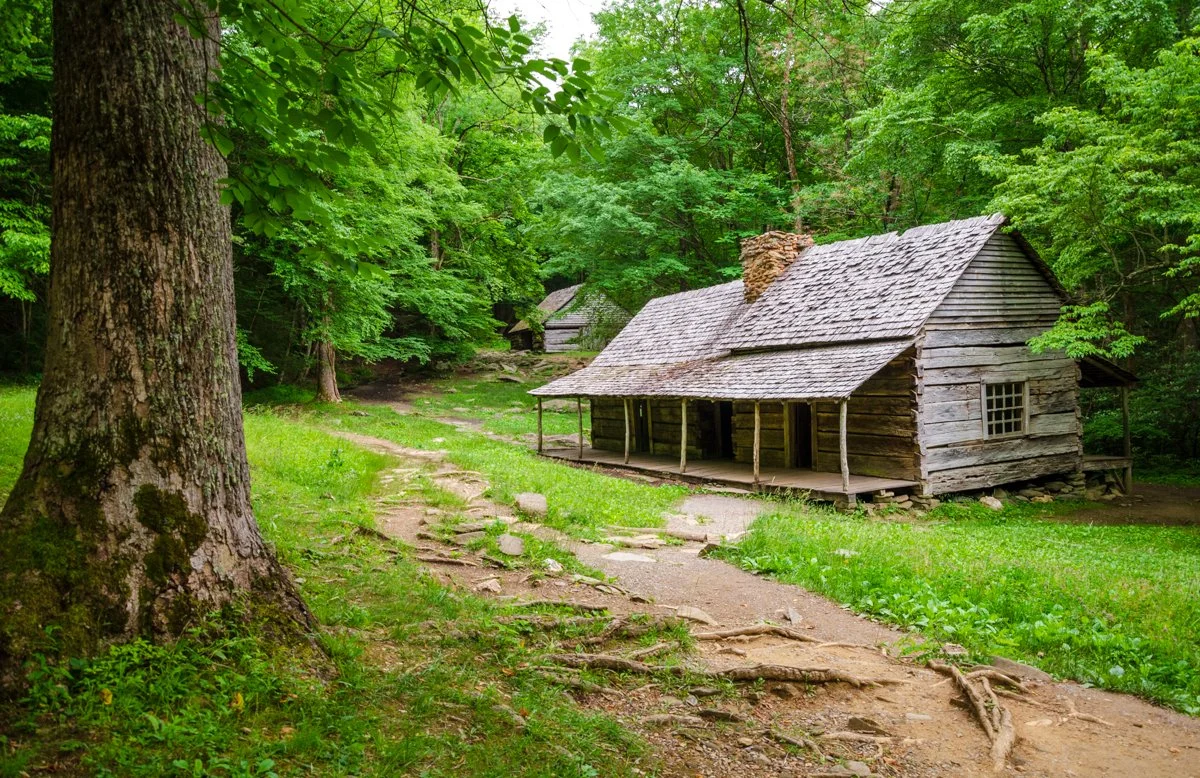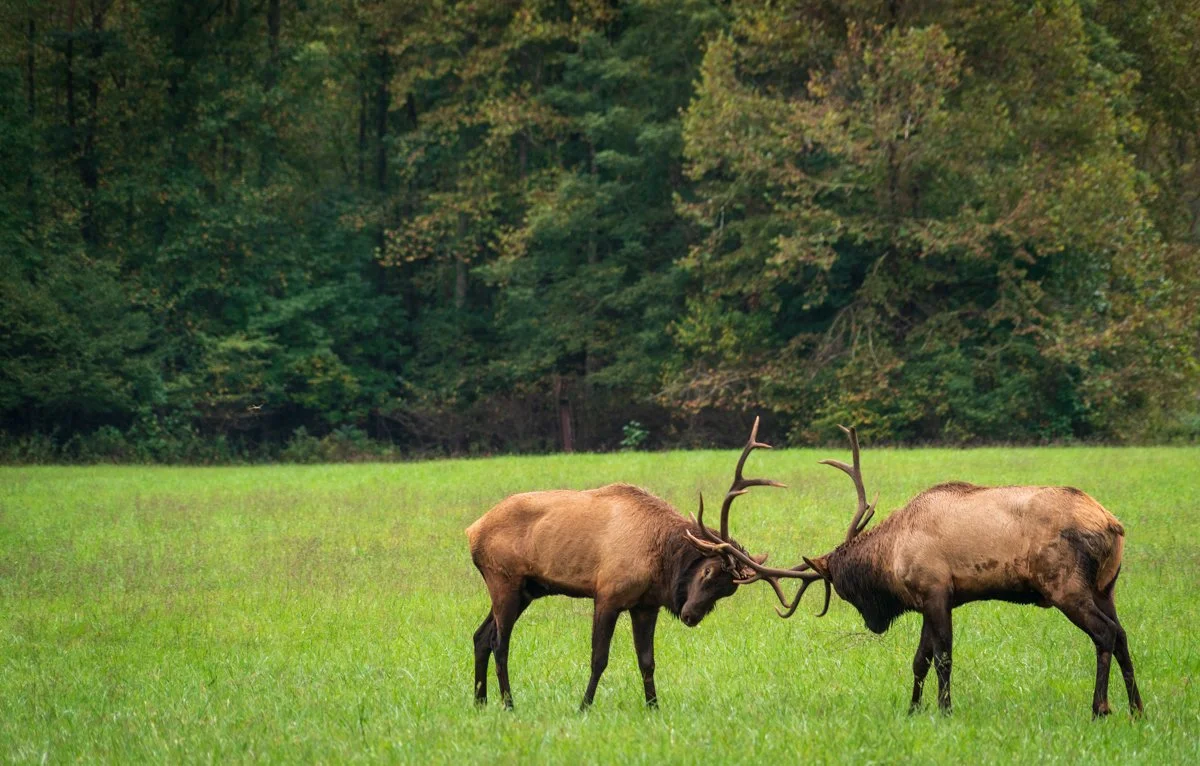Great Smoky Mountains National Park
(North Carolina/Tennessee)
The most famous section of the Appalachian Mountains, Great Smoky Mountains National Park is a breathtaking landscape of lush forests, misty peaks, and abundant wildlife. This enchanting park, renowned for its captivating beauty and remarkable biodiversity, offers visitors a chance to experience the splendor of one of the largest protected areas in the eastern United States.
Established as a national park in 1934, Great Smoky Mountains National Park spans more than 522,000 acres of diverse terrain, including verdant valleys, serene waterfalls, and the soaring peaks of the Smoky Mountains. The park's iconic mountain ranges, such as Clingmans Dome, create a stunning backdrop for exploration and discovery, enticing visitors with their mist-shrouded summits and dense forests.
Great Smoky Mountains National Park is home to an extraordinary array of plant and animal life, which has adapted to thrive in the park's various environments. Iconic species such as black bears, white-tailed deer, and elk inhabit the park's vast expanse, while the skies are home to a plethora of bird species, including the vibrant scarlet tanager and the wood thrush. The park's diverse habitats provide a sanctuary for countless other species, contributing to the rich biodiversity that thrives within its boundaries.
Visitors to Great Smoky Mountains National Park can partake in a wide range of recreational activities that showcase the park's alluring beauty. The park offers more than 850 miles of trails for hiking and backpacking, allowing guests to immerse themselves in the diverse landscapes that define the Smokies. Scenic drives, such as the Cades Cove Loop Road and the Roaring Fork Motor Nature Trail, offer breathtaking vistas and access to popular park destinations. Fishing, wildlife viewing, and camping are also popular activities, providing unique ways to engage with the park's natural wonders.
The nearby communities of Gatlinburg, Pigeon Forge, and Cherokee serve as gateways to Great Smoky Mountains National Park, offering a variety of accommodations, dining options, and local attractions. These vibrant mountain towns ensure that every visitor can experience the park's captivating beauty in comfort and style.
MUST SEE SITES
Cades Cove: This scenic valley is located on the Tennessee side of the park and features stunning views of the surrounding mountains, as well as historic buildings and cultural sites. Visitors can explore the area by taking a scenic drive, hiking one of the park's trails, or simply taking in the stunning views of the valley.
Clingmans Dome: This iconic peak is the highest point in the park and offers stunning views of the surrounding landscape. Visitors can explore the area by taking a guided hike, attending a ranger-led program, or simply taking in the stunning views of the mountains.
Chimney Tops: This iconic mountain is located on the Tennessee side of the park and features stunning views of the surrounding landscape, as well as opportunities for hiking and wildlife viewing. Visitors can explore the area by taking a guided hike, attending a ranger-led program, or simply taking in the stunning views of the mountains.
Oconaluftee Visitor Center and Mountain Farm Museum: This historic village located in the southern part of Great Smoky Mountains National Park offers visitors a chance to explore a unique and fascinating piece of American history. Visitors can explore several historic buildings and farmhouses that were built by early settlers in the region and learn about their way of life. With its rich cultural history and hidden treasures,
Roaring Fork Motor Nature Trail: This scenic drive located in the eastern part of Great Smoky Mountains National Park offers visitors a chance to explore a unique and rugged landscape of waterfalls, forests, and historic buildings. Visitors can drive along the Roaring Fork Motor Nature Trail and enjoy stunning views of the surrounding wilderness.
GETTING THERE
The most popular ways to arrive at Great Smoky Mountains National Park are by car and by air. If you're driving, the park is located on the border of Tennessee and North Carolina and can be accessed via several routes. From the north or south, you can take Interstate 40 to US Highway 441, which leads to the park entrance. From the east, you can take US Highway 441 to the park entrance.
If you prefer to travel by air, the closest airports to Great Smoky Mountains National Park are the McGhee Tyson Airport in Knoxville, Tennessee, and the Asheville Regional Airport in North Carolina. Both airports offer flights from several cities, including Atlanta, Charlotte, and Chicago.
Once you arrive at Great Smoky Mountains National Park, the best way to get around is by car or by shuttle bus. The park has a free shuttle bus system that operates on several routes throughout the park. There are also several hiking trails available for exploring the park's many ecosystems and wildlife, including the famous Appalachian Trail.
GATEWAY COMMUNITIES
The towns of Gatlinburg, Pigeon Forge, and Cherokee serve as the primary gateway communities to Great Smoky Mountains National Park, offering various accommodations, dining options, souvenir shops, and outdoor recreation equipment rentals.
ACCOMMODATIONS
Visitors can find various lodging options in the surrounding communities, including hotels, motels, and vacation rentals. The park itself does not feature lodges or cabins, but there are numerous campgrounds available within the park, providing both tent and RV sites.
CAMPGROUNDS
Great Smoky Mountains National Park has ten developed campgrounds, including Elkmont, Cades Cove, and Smokemont. These campgrounds offer tent and RV sites, as well as basic amenities like restrooms, drinking water, and picnic areas. Some campgrounds require reservations, while others are available on a first-come, first-served basis.
WEATHER/CLIMATE
Great Smoky Mountains National Park has a humid, temperate climate, with mild summers and cool winters. Average summer temperatures range from the 60s to 80s Fahrenheit, while winter temperatures can dip below freezing. Visitors should be prepared for potential rain, snow, and rapidly changing weather conditions.
RECREATION OPPORTUNITIES
Numerous recreational opportunities await visitors, including hiking, backpacking, wildlife viewing, and scenic drives. The park's most popular hike is the Alum Cave Trail, which leads to the summit of Mount LeConte and offers stunning views of the park's landscapes. Other notable hikes include the Chimney Tops Trail and the Charlies Bunion Trail. Wildlife viewing is popular, with a variety of species such as black bears, elk, and white-tailed deer inhabiting the area.
VISITOR CENTER
Great Smoky Mountains National Park has several visitor centers, including Sugarlands Visitor Center, Oconaluftee Visitor Center, and Cades Cove Visitor Center. All provide information about the park's history, ecology, wildlife, and recreational opportunities. Rangers are available to offer guidance and answer questions. The visitor centers are open daily, year-round, with reduced hours and services during the off-season.
THINGS TO KNOW
Entrance Fee: Free (Great Smoky Mountains National Park does not charge an entrance fee)
Pet Policy: Pets are allowed in campgrounds, picnic areas, and along roads, but must be leashed (6-foot maximum) and under control at all times. Pets are not allowed on most trails, with the exception of the Gatlinburg Trail and the Oconaluftee River Trail.
Hours of operation: The park is open 24 hours a day, 7 days a week, year-round, but some secondary roads, campgrounds, and visitor facilities may have seasonal closures or reduced hours.
Website: https://www.nps.gov/grsm/index.htm
Contact phone number: (865) 436-1200
Address: Great Smoky Mountains National Park, 107 Park Headquarters Rd, Gatlinburg, TN 37738, United States





